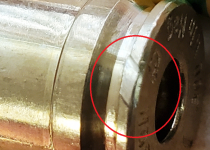Upon closing my bolt on 300 Win Mag brass, it takes considerable force to see the handle down. But after such, the bolt moves freely (easy to lift and extract). Upon opening and closing the test brass (30 times) it eventually became easier to load a piece of brass. The end result was that the rim of the case was shredded to bits, but still usable. So I took a 2nd case and chambered it and just as before, it too was hard to close the bolt with the same result. The image shows what happened when I closed the bolt.
Is it possible that the extractor is just a hair too long trying to get over the rim while closing the bolt? These are new Peterson brass I haven't gotten around to loading due to this issue. I've checked all the measurements of the brass and they are within spec as well.
Is it possible that the extractor is just a hair too long trying to get over the rim while closing the bolt? These are new Peterson brass I haven't gotten around to loading due to this issue. I've checked all the measurements of the brass and they are within spec as well.


